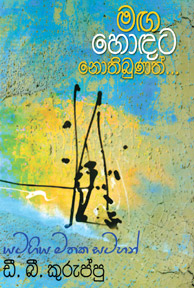Bright array of reminiscences
 The bilingual writer, scholar, administrator, critic and creative
writer D B Kuruppu, among other aspects of his career was a teacher who
had the chance of kindling a keen interest in literature and creative
writing at Ananda College. At the outset I must state that I had the
chance of learning under him during the mid fifties. He was more known
as a theatre and book reviewer to Sinhala newspaper of the time. The bilingual writer, scholar, administrator, critic and creative
writer D B Kuruppu, among other aspects of his career was a teacher who
had the chance of kindling a keen interest in literature and creative
writing at Ananda College. At the outset I must state that I had the
chance of learning under him during the mid fifties. He was more known
as a theatre and book reviewer to Sinhala newspaper of the time.
Kuruppu gradually changed his career to undertake professions in the
field of administration and management. He also took time for
translations and creative writing.
Leaving Sri Lanka he had been living in Australia from where he
continued to write books of varying forms. They include biographies,
reminiscences, folklore, history and anthropology. In two works he tried
to capture some of the most touching episodes from his own experiences
in the social structure which had paved the way for his recollections on
matters that need expression.
Two books have appeared with pages full of such episodes. The first
one appeared under the title: Handavata Payana Hiru (2006) and the
companion volume Maga Hondata Notibunat (2011). Both works envelope
various episodes of lasting interest which surround areas such as people
who mattered, various attitudes and the impact on common lifestyle, of
places visited, and revisited, of love affairs in the university, of
various journeys undertaken, of domestic life packed with various
material encumbrances of comic and tragic incidents. The author is seen
with an uninhibited style of expression in some of the episodes which
concern some people and their behaviour patterns.
 It is said that the dreary and dull times of a person could be
overcome only by expressing them to be known by others. This is clearly
depicted in the works of the two French writers Andre Gide and Marcel
Proust in their works ‘The Counterfeiters’ and ‘Remembering Things of
the Past’ respectively. It is said that the dreary and dull times of a person could be
overcome only by expressing them to be known by others. This is clearly
depicted in the works of the two French writers Andre Gide and Marcel
Proust in their works ‘The Counterfeiters’ and ‘Remembering Things of
the Past’ respectively.
The expressions may not be specified as fiction or narratives, but
could be denoted as narrative expressions of some significance. Kuruppu
recalls 60 such episodes from his variety of experiences shuttling from
the present to the past, and vice versa.
At one moment of his expression he shows that people attempt to show
to the world that they are hail and hearty despite the various ailments
like aches and pains in their arms and limbs. Then he recalls some of
the responses for his companion volume, which appeared first. As it
normally happens in the life of a writer the welcome of garlands is
received while the brickbats are evaded or forgotten.
His encounters with friends, relatives and admirers abound the pages.
The discussions that ensue are resourceful. As a sensitive rationalist
he tries to evade the company of political activities. Nevertheless he
gets at times enmeshed in the same. It seems to the reader that the
subtext of some of the episodes is much more interesting than the actual
recording of the events as they happened. The attention could be drawn
to the encounter with political friends I felt that some of the episodes
recorded pertaining to the field of communication and journalism contain
hitherto unrevealed facts which reveal the conditions and attitudes of
communities of varying types. Some of the episodes are fused with
humorous dialogues, parables are discourses. The felicitation ceremony
to Johnnie is one such example. The author records with a sense of
investigative care some of the love episodes of his friends and
contemporaries who rose to the levels of celebrities. He also records
with intense subtleties some of the frailties of humour who show to the
world that they are invincible. But to him some of them are perhaps
loose characters.
His pilgrimage to Dambadiva, the holy place, is full of material
drawn from various fields such as history, religion, biography,
literature, archeology and excavations. The episode is titled as
Dambadiva Vandanava - a reader would surely consider this creative
travelogue as one of the best pieces written on the subject. I recommend
my students to read and reread this episode as a good lesson in
investigative feature writing. The writer not only takes the reader to
such holy places as Beneras Isipatana and Saranath, but also helps
rediscover the hidden significance of those places with comparative
notes drawn from other sources. In many ways it is a travelogue
interspersed with a human interest. For me as a reader, the entire work
happened to be a page mover resourceful in many ways. This is nothing
but present day belles lettre, a gift to the new generation of Sinhala
readers.
[email protected] |



